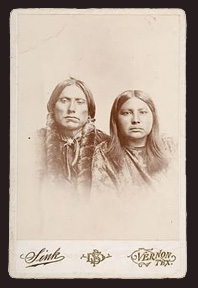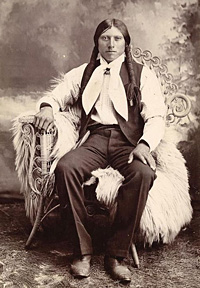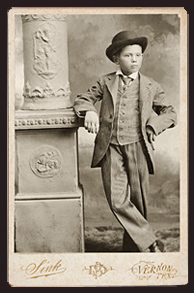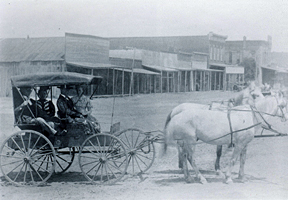

Home About Travel History Genealogy Resources
Americana Journeys - Genealogy History Pioneer Portrait
Daniel P. Sink Photographer
Pioneer Portraits of Vernon, Wilbarger Co. Texas
 Daniel Phillip Sink was born in Davidson, North Carolina in 1846, likely
of German heritage with some of family spellings of the name as Zink. In 1889,
he came to the western town of Vernon, Texas in the famed Red River Valley
and set up a photography studio in a tent on Main Street (where the present
city administration building now stands). He specialized in the popular fad
of the “cabinet card” photo, a portrait of individuals or families
and a card which could be mounted and displayed or sent through the mails to
distant family. Daniel Sink’s place in western history is as a photographer
of Chief Quanah Parker, the last Comanche Chief, who posed in his studio on
multiple occasions.
Daniel Phillip Sink was born in Davidson, North Carolina in 1846, likely
of German heritage with some of family spellings of the name as Zink. In 1889,
he came to the western town of Vernon, Texas in the famed Red River Valley
and set up a photography studio in a tent on Main Street (where the present
city administration building now stands). He specialized in the popular fad
of the “cabinet card” photo, a portrait of individuals or families
and a card which could be mounted and displayed or sent through the mails to
distant family. Daniel Sink’s place in western history is as a photographer
of Chief Quanah Parker, the last Comanche Chief, who posed in his studio on
multiple occasions.
Vernon, in Wilbarger County, Texas lies near the border of Texas and Oklahoma, about 30 miles from Wichita Falls. In its founding days it was the prototypical western cattle drive town of the Hollywood movies (think John Wayne in “Red River”). When cattle droves on the Great Western Trail crossed the Red River on their way north to the first rail heads in Kansas and Nebraska. You can find museums to the Great Western Trail in Vernon.
The Red River Valley area around Wilbarger County was a part of the buffalo hunting grounds of the Nokoni (Nawkonnee) Wanderer Band of Comanche Indians up until the 1870s, when the buffalo hunts of the whites destroyed the vast herds. The Red River War campaigns between the U.S. Army Cavalry with the fierce Comanche was the stuff of legends until the Comanche eventually capitulated Fort Sill in 1875, and the Indians removed to the north to what was deemed Indian Territory.
 Quanah Parker himself, was the son of a white mother taken
as a girl in a Comanche raid and taken back again by Texas Rangers when
he was a young boy.
Quanah
Parker found a way to straddle the world of the white man and maintain his
Indian culture. In 1878, a supply store named Doan's was established at the trail crossing
point of the river, and was the last place to get mail and supplies, guns
and ammunition before entering by then "Indian Territory" on the
cattle trail. The town which grew around it to support the cattle drives
had a hotel,
a restaurant and saloon, a drug store, a wagon yard and branding pens with
corrals. Cattle on the trail began to decline in 1885 with the development
of barbed wire across the cattle ranges. The cattle traffic dwindled until
the last major drive crossed the Red River headed to Deadwood, South Dakota
in 1893.
Quanah Parker himself, was the son of a white mother taken
as a girl in a Comanche raid and taken back again by Texas Rangers when
he was a young boy.
Quanah
Parker found a way to straddle the world of the white man and maintain his
Indian culture. In 1878, a supply store named Doan's was established at the trail crossing
point of the river, and was the last place to get mail and supplies, guns
and ammunition before entering by then "Indian Territory" on the
cattle trail. The town which grew around it to support the cattle drives
had a hotel,
a restaurant and saloon, a drug store, a wagon yard and branding pens with
corrals. Cattle on the trail began to decline in 1885 with the development
of barbed wire across the cattle ranges. The cattle traffic dwindled until
the last major drive crossed the Red River headed to Deadwood, South Dakota
in 1893.
The Fort Worth and Denver City Railway began construction in 1881 and arrived in Wichita Falls in 1882, and connecting to Denver by 1888. Wilbarger County and its capital, by then renamed Vernon began to attract settlers for the farming land, mostly cotton and wheat, and Daniel Sink saw the opportunity. He arrived from Calvert, Texas in March of 1889 with the new wife he had married there and set up his studio on South Main Street. Mrs. Sink in later days recalled of the time, “On Main Street proper were some frame buildings full of bullet holes from the pistols of cowboys who came to Vernon on pay day and would practice on the houses as they rode down the street.” She said that some of her neighbors would cover their windows at night to keep the cowboys from shooting out their lights, and recalled the great cattle herds through the heart of town.
 Cabinet Card photography came into popularity in the
late 1860s following the Civil War. The new larger format of generally
4 ½ X 6 ½ inches
allowed mounting of a photograph that was easy to view and could be displayed
on cabinet furniture. The format also allowed the photographer to print
their name and advertising on the front of the card. The style was particularly
popular
up through the 1890s as the west became firmly settled.
Cabinet Card photography came into popularity in the
late 1860s following the Civil War. The new larger format of generally
4 ½ X 6 ½ inches
allowed mounting of a photograph that was easy to view and could be displayed
on cabinet furniture. The format also allowed the photographer to print
their name and advertising on the front of the card. The style was particularly
popular
up through the 1890s as the west became firmly settled.
Daniel Sink’s photography business was quite successful, advertising
regularly, and he remained in Vernon until 1919 when at the age of 74,
finally sold his studio to a Mr. Clifton and moved to Southern California
to retire.
He died in 1931 in Los Angeles near Glendale. How many of his photographs
still exist is hard to know. Some can be identified by his name and studio
on the
bottom, while others can be determined by the rather distinctive studio
set pieces he used in his early photographs. Which is how I came across
him, through
a family connection.
Aside from the photographs of Chief Quanah Parker, he photographed assorted cowboys and settlers. One family who arrived in Vernon Texas about 1893, just in time for the last great cattle drive was a retired railroad worker turned farmer named James Henry Amend. He had been following the building the railroads of the Missouri-Kansas-Texas Railroad (Katy) and the St. Louis-San Francisco Railroad (Frisco) from Missouri though Kansas and Indian Country for thirty years. The depression of 1893 brought an end to the rapid railroad expansion through the west and may have been the end of his railroad work a beginning of life as a farmer. He had married Alice Florence Sweet in Labette County, Kansas, in 1873, had born three children in Indian Territory and buried a child in Arkansas, and when the Katy acquired the line to Wilbarger, he followed it to settle.
 Soon on their arrival, they found the photography tent
or saw an advertisement and decided to have a photo struck of William
Henry Amend at the age
of about five and his sister Lily May Amend about the age of two.
He later
photographed
the whole family of James Henry and Alice Florence Amend, their six
living children and a daughter-in-law in 1900 to commemorate the
Centennial, and may or may not have been the one to take a street photograph
of
some
of
the family
in their buggy on the main street of Vernon. James Amend must have
prospered after 30 years of hauling ties for the railroads for such
a snappy suit
for his five year old son during a depression and draw the attention
of the city
photographer.
Soon on their arrival, they found the photography tent
or saw an advertisement and decided to have a photo struck of William
Henry Amend at the age
of about five and his sister Lily May Amend about the age of two.
He later
photographed
the whole family of James Henry and Alice Florence Amend, their six
living children and a daughter-in-law in 1900 to commemorate the
Centennial, and may or may not have been the one to take a street photograph
of
some
of
the family
in their buggy on the main street of Vernon. James Amend must have
prospered after 30 years of hauling ties for the railroads for such
a snappy suit
for his five year old son during a depression and draw the attention
of the city
photographer.
Sources: FindaGrave, LostGallery, Eve Arnold, Census Records